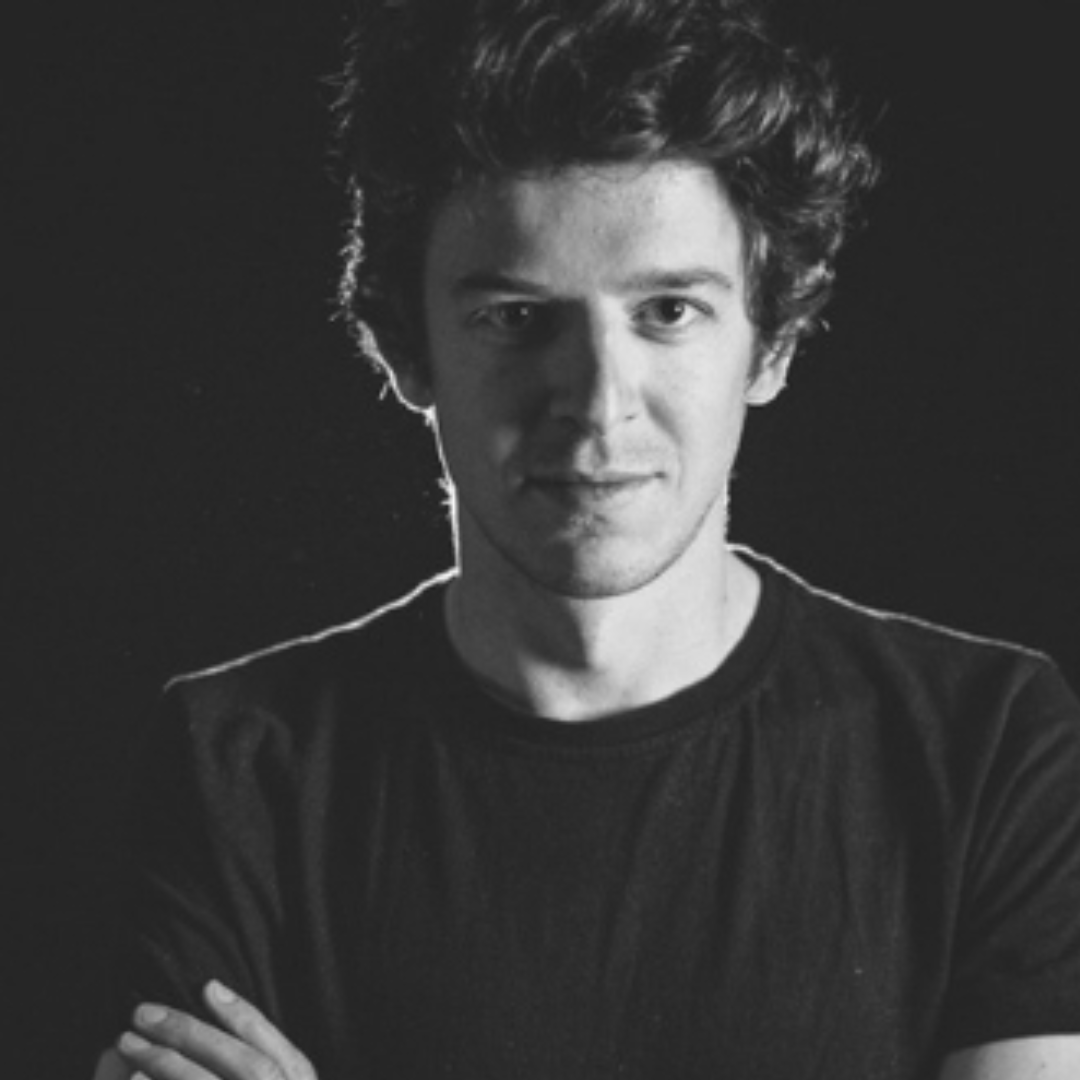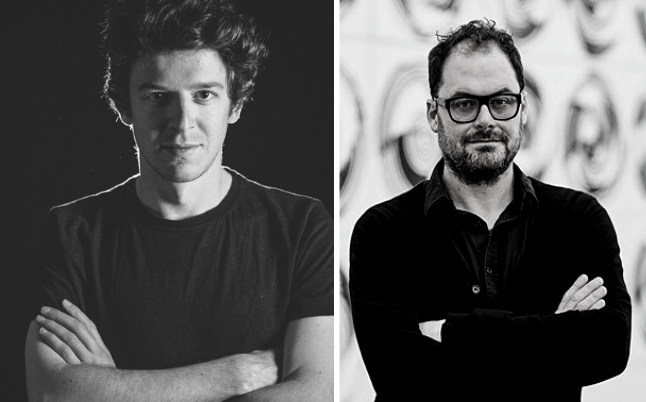 from left: Alex Taylor and Simon Ingram
from left: Alex Taylor and Simon Ingram
How did the collaboration with visual artist Simon Ingram come about? Did you know each other already?
We were introduced by our mutual friend Marc Taddei, Orchestra Wellington’s brilliant Music Director. Marc saw some common interests in our work and asked us to make a piece together for the 2019 season.
We understand that Simon’s autonomous painting robots are involved. How does the robot interact with the music? Did this influence your writing process?
It’s rather the other way around. Most of the compositional process for me involved working out a musical language that could blend with, extrapolate from, frame, dialogue with, the sounds and shapes that Simon’s painting machine made, and translating that into the orchestral medium. In this way, it’s not so different from Pictures at an Exhibition, except that the source material is alive and an active part of the piece.
It was a given that the machine was creating a visual object, and that its movements and what it painted would form part of the performance, but one of the generative questions when we first got together was, what does this thing actually Sound like?
Simon spent a lot of time experimenting with contact mics. We tested different types of movements in terms of the sounds they produced; some of the correlations between a type of line and the sounds it produced were quite unexpected, for example the curve of a circle required a series of short bursts with changes of gradient and frequency, and often the gaps between painted lines (i.e. the machine moving from one place to another in between painting) produced sounds that were just as interesting as when the brush was on the canvas. In the end Simon came up with something that was both a satisfying visual composition and an interesting mixture of long and short, rising and falling sounds.
What practical considerations did you have to take into account?
We discussed various options in terms of the interaction between robot and orchestra. Were the robot and orchestra in opposition, or synergy, or a mixture of the two? We’ve attempted to create something of a hyper-instrument, where the binaries of digital/analogue and human/mechanical are somewhat collapsed. The physical constraints of the robot mean that it takes a long time to do anything, so we decided that the programming of the robot should dictate the form of the music, rather than the other way around. Simon has created a painting that takes about 11 minutes to complete, and I’ve written orchestral music that is overlaid on that, taking into account the visual forms as well as the sounds we hear from the machine. In this way, it’s a bit like a film score: there’s a degree of synchronisation we wanted to achieve, and having a relatively fixed element (the coding of the robot) made that easier.
So, the movements of the robot are predetermined, reliably repeatable in performance, but I’ve tried to create an orchestral canvas that can be a little bit flexible, and not require extremely pedantic micro-level synchronisation. I wanted the orchestra to maintain its live-ness, to give Marc and the orchestra a degree of flexibility of expression within a macro-structure.
The title ‘Assemblage’ reflects that flexibility and the somewhat abstract, cool nature of the visual and sonic material.
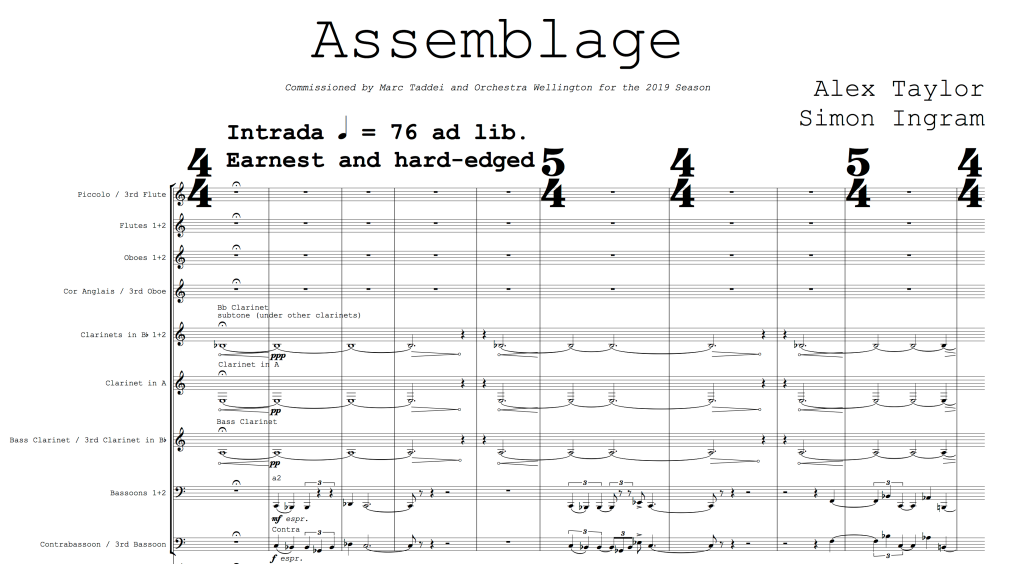 Assemblage bar 1-9, winds.
Assemblage bar 1-9, winds.
How much did you consult with Simon while composing?
To me this was a true collaboration, one where both Simon and I were able to develop a shared concept but contribute within our own disciplines. There was a measure of compromise involved too – Simon’s paintings are usually much more complex and intricate, but the speed of the machine meant that for a live concert performance this had to be considerably simplified; I’m used to having pretty much complete structural freedom in writing concert music, so it was challenging (but stimulating) for me to map a musical structure over the top of a mechanical scaffold.
We consulted a lot, particularly in the early stages of formulation and testing, but there was also an acknowledgment of the division of labour – Simon would come up with a composition first, and then I would create an orchestral canvas around it.
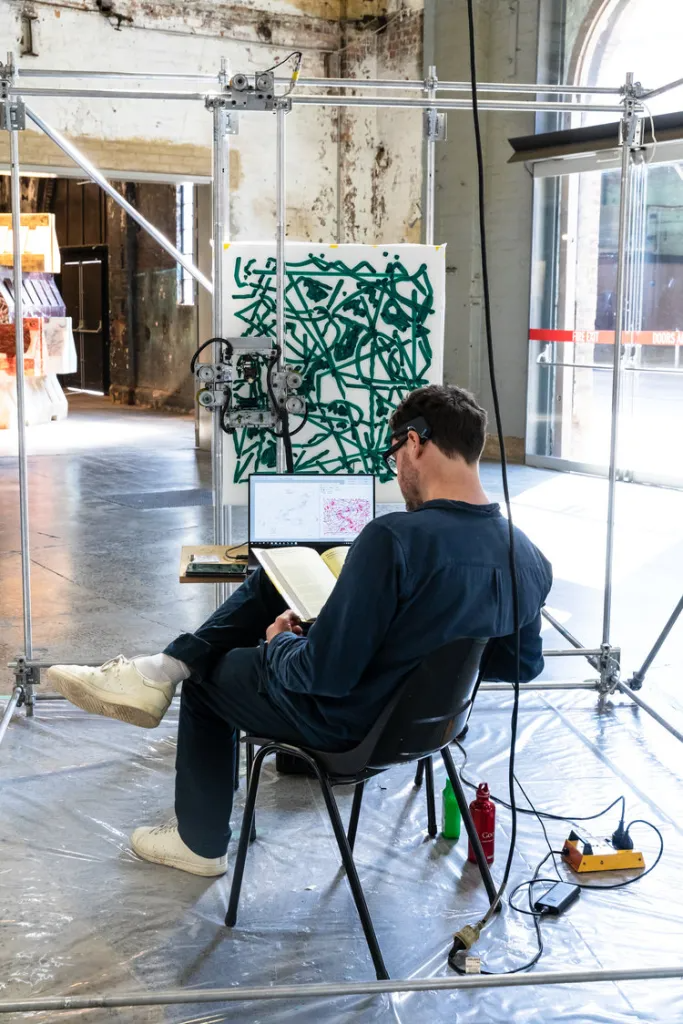 Simon Ingram, with painting robot
Simon Ingram, with painting robot
What can the audience expect to see and hear?
As I mentioned above, the robot moves quite slowly, so there’s an inexorable quality to the piece – we can see the composition forming in real time, the robot making shapes on the canvas – I’m reminded of the Malevich Suprematist paintings.
Sonically, the audience will hear a mixture of amplified (mechanical) and acoustic (instrumental) sound. The orchestra draws on many of the gestural elements of the robot – lines, gradients, curves, expansion and contraction. Much of the work is built on a series of slow moving chromatic harmonies – chords that expand outwards or inwards very gradually, often by a quartertone, so there’s a constrained, resistant quality to the sound. But it too has an inexorable quality, like a rubber band being pulled, and it’s quite fun when it releases all that elastic energy (or snaps)!
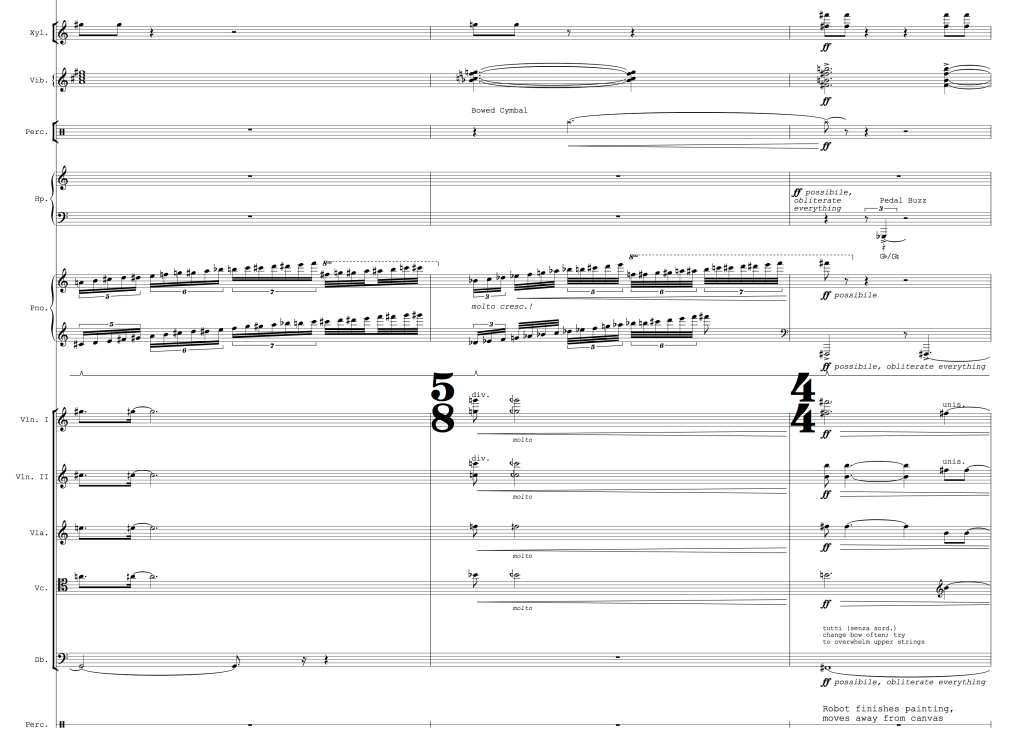 Assemblage bar 284-286 percussion and strings
Assemblage bar 284-286 percussion and strings
Congratulations on being accepted into the Doctoral programme at the University of California, San Diego. What made you choose UCSD?
UCSD is great in a number of ways – primarily I think it’s a community of all sorts of strange and diverse practices and people. One of the attractions was the fact that they have a doctoral level performance programme that runs alongside Composition, Computer Music, and Integrative Studies – unlike many of the other US Composition programmes there’s a focus on collaboration and integration of different disciplines. Another attraction is that I’ve worked with a number of the graduate students before. I got to know a group of wonderful UCSD grads being involved with Tautitotito, a music theatre show we created for the Darmstadt Ferienkurse, led by the indomitable Celeste Oram. I’ve recently been hanging out with Celeste and her partner Keir GoGwilt at the Nelson Composers Workshop; Keir is one of the finest violinists of our time and Wellington audiences can hear him and Celeste featured in Stroma’s concert on August 1.
Who will your teachers be?
There’s a great composition faculty that includes Natacha Diels, Katarina Rosenberger, Chinary Ung, Anthony Davis, Rand Steiger, Lei Liang and Roger Reynolds. I’ll get to study with several different composition faculty in my first year before choosing a supervisor and working out a path forward from there. As I alluded to above though the strength of UCSD is in lots of different areas, so there are other faculty I’m looking forward to getting to know, like the cellist Charles Curtis and clarinettist Anthony Burr. Probably the most famous name at UCSD is Steve Schick, so I imagine I won’t escape without writing more than a little percussion music.
How long is the programme?
It’s at least five years!
What are you most looking forward to?
A new environment, a different pace; I’m looking forward to jumping headfirst into anything and everything, putting on some great shows, saying yes to every possible project, making mistakes, happy accidents, hard work, having fun! I’ve been out of university for a long time, which will have its benefits and challenges; I might have a different perspective from other students coming straight from a Master’s programme. I’m looking forward to San Diego’s renowned craft beer scene!
What other projects do you have coming up?
Some very exciting projects lined up for the next couple of years. I’m not sure how many I can mention explicitly, but I can give some more-or-less vague indications: a piece for Ensemble Proton in Bern (SOUNZ readers might know their formidable clarinettist Richard Haynes); a new concerto; a duo for a US-based ensemble; a Beethoven-related collaboration; some songs… that’s more than enough to keep me going.
Also looking forward to seeing the SOUNZ films of my Flute Concerto and Three Preparations; SOUNZ, RNZ and especially Chris Watson continue to do an excellent job of preserving and disseminating our music through film.
SOUNZ blog is designed for expressive discussion and debate amongst the arts and broader community. This is intended to be a safe space so please remember to keep comments respectful and avoid personal attacks, criticisms of specific organisations and defamatory language. Comments are moderated to ensure that they comply with SOUNZ’s Community guidelines.
